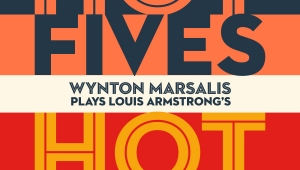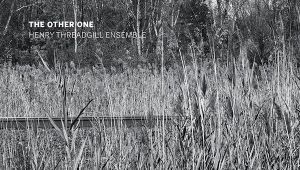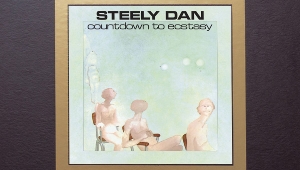| Columns Retired Columns & Blogs |
Recording of June 2010: Emotion & Commotion
Jeff Beck: Emotion & Commotion
Atco R2 523695 (CD), R1 523695 (LP). 2010. Steve Lipson, prod., eng., mix; Trevor Horn, exec. prod. DDD. TT: 40:26
Performance *****
Sonics ***½
Atco R2 523695 (CD), R1 523695 (LP). 2010. Steve Lipson, prod., eng., mix; Trevor Horn, exec. prod. DDD. TT: 40:26
Performance *****
Sonics ***½
Hindsight tells me that I shouldn't have been surprised: the pairing of the most lyrical of electric guitarists with the supreme melody from a king of melody, Giacomo Puccini, was a natural match. Jeff Beck wrings the emotion from his Fender Stratocaster on the aria "Nessun Dorma," from the opera Turandot, and sends it soaring, singing into the aether.
 There are three instruments that echo the tessitura of the human voice: the cello, the tenor saxophone, and the electric guitar. In the hands of a master, each can sing, but no one can rival Jeff Beck when it comes to making the guitar sound truly like a voice. This might seem paradoxical: the guitar is a plucked, fretted instrument—how can it emulate the inflexions of the voice? Beck's preferred Stratocaster has a bridge design that encourages sustain; in addition, with the instrument overdriving the input stage of a Fender or Marshall tube amplifier, the note played can be made to swell and change its character as it does so; and by bending the note once it's been plucked, the player can add vibrato or grace notes. Beck's extraordinary virtuosity also involves rotating the guitar's level controls with his little finger, and using the instrument's tremolo or "whammy bar" to voice each note.
There are three instruments that echo the tessitura of the human voice: the cello, the tenor saxophone, and the electric guitar. In the hands of a master, each can sing, but no one can rival Jeff Beck when it comes to making the guitar sound truly like a voice. This might seem paradoxical: the guitar is a plucked, fretted instrument—how can it emulate the inflexions of the voice? Beck's preferred Stratocaster has a bridge design that encourages sustain; in addition, with the instrument overdriving the input stage of a Fender or Marshall tube amplifier, the note played can be made to swell and change its character as it does so; and by bending the note once it's been plucked, the player can add vibrato or grace notes. Beck's extraordinary virtuosity also involves rotating the guitar's level controls with his little finger, and using the instrument's tremolo or "whammy bar" to voice each note.
When he heard Beck's 2007 version of Stevie Wonder's "'Cause We've Ended As Lovers," assistant editor Stephen Mejias, himself a guitarist, wondered aloud that Beck plays as if he has fingers at the ends of his fingers. Not only that, but Beck's chops are matched by his musical taste. While two generations of shredders now emulate his ability to produce cascades of notes, they all miss the fact that, even when he does so, Beck still plays only the notes that matter, still leaves room for implication as well as extrapolation, still keeps his awesome facility in service to the song.
Emotion & Commotion is the first music-only album in seven years from the guitarist, who is now 66 years old. However, his 2009 video Performing This Week . . . Live at Ronnie Scott's (DVD-V, Eagle Vision 30263-9) gave his fans a full serving of the virtuosity offered by his most recent touring band—the extraordinary Tal Wilkenshaw on bass, Zappa alum Vinnie Colaiuta on drums, and Jason Rebello on keyboards—in their all-too-short set on the second Eric Clapton Crossroads Guitar Festival 2007 DVD (Rhino R2 352124). That band appears on three tracks of E&C; featured on other cuts here are bassists Pino Palladino and Chris Bruce and drummers Allesia Mattalia, Earl Harvin, and Clive Deamer—A-list sidemen/women all—but consistency throughout the album is provided by Pete Murray's keyboards and orchestral arrangements.
The album opens with Beck channeling the late Jeff Buckley, who himself was channeling Dame Janet Baker, on Benjamin Britten's "Corpus Christi Carol." Accompanied by a 64-piece orchestra, Beck continues his exploration of the Stratocaster's lyrical sustain, which he demonstrated to such good effect on "Where Were You?," from his album Guitar Shop (1988). This segues into the riff-dominated "Hammerhead," which illustrates Beck's other side: his ability to make his instrument sound as if it's "being sick," as he described it in the liner notes for Truth (1968).
The lyrical side of Beck's playing resurfaces in, of all things, "Somewhere Over the Rainbow," which he makes almost new again, and in another song made famous by Jeff Buckley, James Shelton's "Lilac Wine," where he is joined by singer Imelda May. Two other ladies make vocal appearances: Brit rocker Joss Stone, on Screaming Jay Hawkins' "I Put a Spell on You" and "There's No Other Me," which Stone wrote with Jason Rebello; and Olivia Safe, who turns in a gorgeous vocalise on Dario Marianelli's "Elegy for Dunkirk," from the film Atonement, which closes the album. And in "Serene," Safe doubles Beck's guitar lines with wordless phrases prefaced by Tuvan throat singing, the latter illustrating the fact that not every idea fulfills its promise.
"Elegy for Dunkirk" again features an orchestral backing; in the press release for Emotion & Commotion, Beck says the idea of using an orchestra evolved from the version of Gustav Mahler's Symphony 5 he recorded a few years ago but never released. "It turned out amazingly well, but I didn't want to commit to an entire album of classical music. What appealed to me instead was the idea of bringing together these seemingly contradictory sounds on different kinds of nonclassical music."
The risk that such an approach runs is that you end up with a collection of disconnected tracks rather than a through-composed album. But the common voices of Beck's virtuosity and Murray's orchestrations and arrangements tie E&C together most effectively.
The CD sound is a little compressed compared with Guitar Shop, or Beck's platinum-selling Blow By Blow and Wired albums from the mid-1970s, and offers less space than the best tracks on Shop, but overall sounds cleaner, with better extension at the frequency extremes. The orchestral sound tends to be a little on the generic side, with the over-warm lower mids endemic in film soundtracks, but the band tracks are impeccably mixed. The gatefold-sleeved, 180gm LP moves "Serene" to the start of side 2, so that side 1 can end with "Nessun Dorma," but otherwise matched the CD sound. Play it again, Mr. Beck.—John Atkinson
- Log in or register to post comments




































